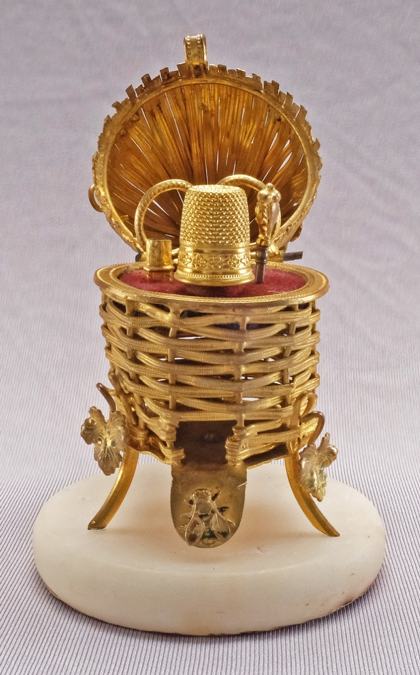

Brass etui (a container or bag for holding sewing items) in the shape of a beehive on a polished alabaster base. The bee is at the base about to enter the door, above are leaves and bumblebees. The kit is fitted with gold tools including a thimble, scissors and stiletto, made in France circa 1860, Gift of Pat Grappe, TTU-H2018-061-019. Photos courtesy of the Museum of Texas Tech University.
Tiny Treasures
by Marian Ann J. Montgomery, Ph.D.
Curator of Clothing and Textiles, Museum of Texas Tech University
New quilting tools are fun to share with quilting friends. Remember how they oohed and ahhed when you trotted out your new pincushion, pretty scissors, sewing machine or other gadgets at the last retreat? Well, we have nothing on the stitchers from the 18th and 19th centuries. Ladies may not have had the Internet or cell phones, but they had the coolest and most beautiful tools for needlework! The bee hive etui is a perfect example. Not only were they fun to use, but they also showed a woman's social status - the same way flashy jewelry, cars, or expensive handbags do in today's society.
In the past few years the Museum of Texas Tech University has received hundreds of beautiful needlework tools and toolboxes, mostly collected by a few needle workers, some of whom quilt. In preparation for the objects to be secured in exhibit cases, the museum team prepared a video showing the items, little details, and how they worked, something likely missed when glancing at an exhibit case.
When it is able to open again, the Museum plans an exhibit of these and other objects, Sumptuous Stitches and Tiny Treasures. This major exhibit will include over 750 objects, the majority of which are needlework tools. A full color catalog of the objects will be available for sale online. For the updated exhibit schedule and how to order the exhibition catalog, visit the Museum’s website here, or contact the curator at marian.ann.montgomery@ttu.edu.
Learn more about the Clothing and Textiles Collection at the Museum of Texas Tech University.
Click here for related articles from the Museum of Texas Tech University Textile Collections.




.jpg)



RSS feed for comments to this post